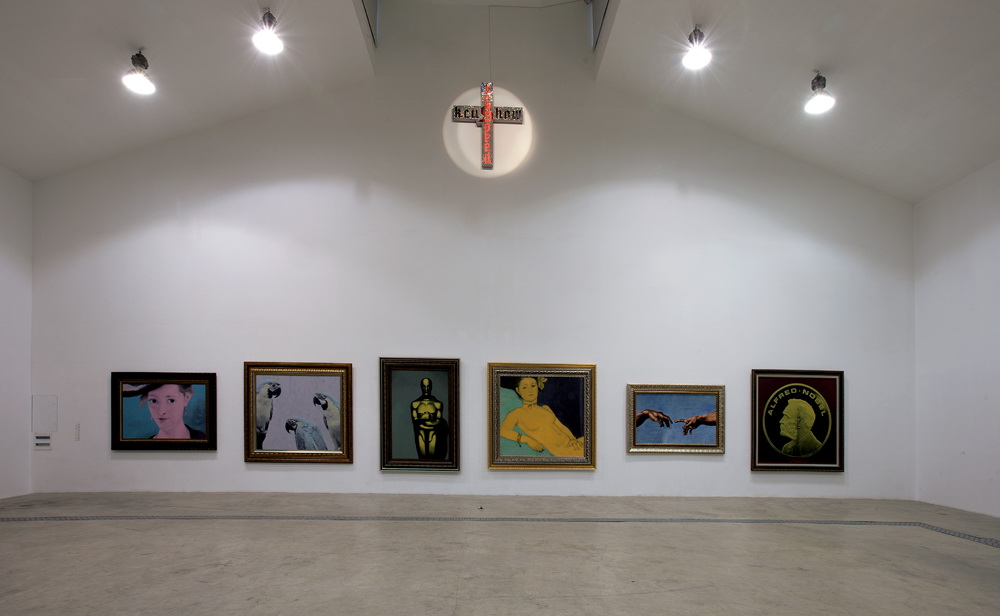巴洛克一词的原意是奇异古怪,文艺复兴后期的古典主义者用它来称呼这种被认为是离经叛道的艺术风格。巴洛克时期的艺术华丽而炫耀,充斥着宗教的崇拜却又带着强烈享乐主义的色彩。
作为观念绘画的艺术家,颜磊向来把绘画作为一种语言的可能性和策略,阐述得是他对艺术以及当代社会文化生活的感受和态度。 颜磊以“巴洛克”为起点的绘画系列,攫取了西方绘画经典里各种能够体现“巴洛克”精神层面的碎片,加以复制和夸张。在他的混搭之下,我们看到鲁本斯“苏姗娜﹒芙尔曼肖像”浪漫唯美的女性形象诱惑的眼神; 以及“三美神”里女神那丰腴肉感的美丽脸孔; 马奈的“奥林匹亚”更是赤裸裸的肉欲和引诱; 绚烂的鹦鹉带着着现实却夸张和浮华的羽毛 ; 各种代表文学和艺术的最高荣誉的奖杯“诺贝尔”或是“奥斯卡”,被米开朗基罗“创世纪”中暗示奇迹的神秘宗教感指尖所点化。这些经典艺术的碎片带着种种精神暗示被膨胀和放大,并蒙上现代波普的亮丽色彩,还加以高档的奢华巴洛克式外框,将当代艺术与生活中的欲望膨胀和享乐主义直观地传达出来。
彩轮的方式源自于牛顿对可见之光的研究,是歌德赋予这个彩轮以精神和人文主义的联想。这个方式经由约翰﹒伊顿所创立的包豪斯色彩分析理论而成为西方现代主义的经典。这次颜磊全新的彩轮系列虽然每张都色彩丰富,但却是出自于同一灰度,如果用黑白相机进行拍摄,我们看到的是一张张色彩统一均匀的圆形或方块。这些彩轮在视觉上的绚烂效果和物理实质的反差正印证了颜磊对于色彩理论本身的不信任,而彩轮工业化的生产模式更是对艺术的价值体系的挑衅。光谱的无穷无尽赋予了颜磊彩轮系列的永久可能性,从而让他的“无限艺术计划”有了无限的发展空间。
他通过观念性的创作所探讨的是艺术的基本问题:艺术面对无庸置疑的西方传统霸权的关系,全球资本将艺术转化为商业模式的现状,以及在这个信息主宰的时代下图像的功能,等等……
颜磊的巴洛克,带着华丽的外框与炫耀的色彩,以夸张浮华的表象演绎着他对于艺术的真诚。
作为观念绘画的艺术家,颜磊向来把绘画作为一种语言的可能性和策略,阐述得是他对艺术以及当代社会文化生活的感受和态度。 颜磊以“巴洛克”为起点的绘画系列,攫取了西方绘画经典里各种能够体现“巴洛克”精神层面的碎片,加以复制和夸张。在他的混搭之下,我们看到鲁本斯“苏姗娜﹒芙尔曼肖像”浪漫唯美的女性形象诱惑的眼神; 以及“三美神”里女神那丰腴肉感的美丽脸孔; 马奈的“奥林匹亚”更是赤裸裸的肉欲和引诱; 绚烂的鹦鹉带着着现实却夸张和浮华的羽毛 ; 各种代表文学和艺术的最高荣誉的奖杯“诺贝尔”或是“奥斯卡”,被米开朗基罗“创世纪”中暗示奇迹的神秘宗教感指尖所点化。这些经典艺术的碎片带着种种精神暗示被膨胀和放大,并蒙上现代波普的亮丽色彩,还加以高档的奢华巴洛克式外框,将当代艺术与生活中的欲望膨胀和享乐主义直观地传达出来。
彩轮的方式源自于牛顿对可见之光的研究,是歌德赋予这个彩轮以精神和人文主义的联想。这个方式经由约翰﹒伊顿所创立的包豪斯色彩分析理论而成为西方现代主义的经典。这次颜磊全新的彩轮系列虽然每张都色彩丰富,但却是出自于同一灰度,如果用黑白相机进行拍摄,我们看到的是一张张色彩统一均匀的圆形或方块。这些彩轮在视觉上的绚烂效果和物理实质的反差正印证了颜磊对于色彩理论本身的不信任,而彩轮工业化的生产模式更是对艺术的价值体系的挑衅。光谱的无穷无尽赋予了颜磊彩轮系列的永久可能性,从而让他的“无限艺术计划”有了无限的发展空间。
他通过观念性的创作所探讨的是艺术的基本问题:艺术面对无庸置疑的西方传统霸权的关系,全球资本将艺术转化为商业模式的现状,以及在这个信息主宰的时代下图像的功能,等等……
颜磊的巴洛克,带着华丽的外框与炫耀的色彩,以夸张浮华的表象演绎着他对于艺术的真诚。
–文 王贝莉
Originally, the word “baroque” meant “strange,” which is why classicists in the late Renaissance used this word to name the artistic style they considered rebellious. The art of the Baroque period is magnificent, ostentatious, and permeated by religious adoration and a strong sense of hedonism.
Yan Lei is a conceptual painter who always use painting as a linguistic possibility and strategy to reflect his thoughts and feelings about art, contemporary society, life and culture. Yan Lei’s new series is inspired by the Baroque, seizing the fragments of classic European painting that embodies the Baroque spirit, to which he adds the elements of reproduction and exaggeration. In the mixture of his creation, we see the seductive gaze and romantic aesthetic of the female form in Rubens’ Portrait of Susanna Fourment and the sexy, materialized face of the Muse from Three Graces, and the even more nakedly lustful and seductive Olympia by Manet. We also see splendid parrots wearing their outrageously flashy feathers, the highest awards in literature and art, such as the Nobel and the Oscar, and the fingertips in Michelangelo’s Genesis representing a hint of the mystical, the religious, and the miraculous. Positioned in the luxurious baroque frames, these fragments of classical art expand and enlarge spiritual suggestion and encompass the beauty of modern Pop. Yan expresses directly the expanding of desire and it’s belief in hedonism of contemporary art and life.
The colour wheel originated from Newton’s research on visible light, but it was Goethe who gave the colour wheel its spiritual and humanistic association. It then became a classic of Western modernism due to Johannes Itten’s Bauhaus theory of colour analysis. Here, in this new series of colour wheels of Yan Lei, in spite of the richness of colour of each painting, they come from the same degree of grey. If you were to use a black and white camera to photograph them, you would see the different circle or square characterized by homogenized colour. The contrast between the visual splendor and physical substance of these colour wheels confirms Yan Lei’s doubts about colour theory itself; the industrialized production model of the colour wheel is meant to challenge value system of art. The inexhaustibility of the spectrum gives Yan Lei’s Colour Wheel series infinite possibilities, thereby giving his “limitless art project” limitless space for development.
Yan uses conceptual creation to explore the fundamental question of art. Art confronts the unquestionable relationships of traditional Western hegemony, the transformation of art into a commercial model by global capitalism, and the function of the image in an era dominated by mass media.
Magnificent frames and splendid colours distinguish Yan Lei’s baroque; he uses these embellished and gorgeous surfaces to show his sincerity toward art.
Yan Lei is a conceptual painter who always use painting as a linguistic possibility and strategy to reflect his thoughts and feelings about art, contemporary society, life and culture. Yan Lei’s new series is inspired by the Baroque, seizing the fragments of classic European painting that embodies the Baroque spirit, to which he adds the elements of reproduction and exaggeration. In the mixture of his creation, we see the seductive gaze and romantic aesthetic of the female form in Rubens’ Portrait of Susanna Fourment and the sexy, materialized face of the Muse from Three Graces, and the even more nakedly lustful and seductive Olympia by Manet. We also see splendid parrots wearing their outrageously flashy feathers, the highest awards in literature and art, such as the Nobel and the Oscar, and the fingertips in Michelangelo’s Genesis representing a hint of the mystical, the religious, and the miraculous. Positioned in the luxurious baroque frames, these fragments of classical art expand and enlarge spiritual suggestion and encompass the beauty of modern Pop. Yan expresses directly the expanding of desire and it’s belief in hedonism of contemporary art and life.
The colour wheel originated from Newton’s research on visible light, but it was Goethe who gave the colour wheel its spiritual and humanistic association. It then became a classic of Western modernism due to Johannes Itten’s Bauhaus theory of colour analysis. Here, in this new series of colour wheels of Yan Lei, in spite of the richness of colour of each painting, they come from the same degree of grey. If you were to use a black and white camera to photograph them, you would see the different circle or square characterized by homogenized colour. The contrast between the visual splendor and physical substance of these colour wheels confirms Yan Lei’s doubts about colour theory itself; the industrialized production model of the colour wheel is meant to challenge value system of art. The inexhaustibility of the spectrum gives Yan Lei’s Colour Wheel series infinite possibilities, thereby giving his “limitless art project” limitless space for development.
Yan uses conceptual creation to explore the fundamental question of art. Art confronts the unquestionable relationships of traditional Western hegemony, the transformation of art into a commercial model by global capitalism, and the function of the image in an era dominated by mass media.
Magnificent frames and splendid colours distinguish Yan Lei’s baroque; he uses these embellished and gorgeous surfaces to show his sincerity toward art.
By Beili WANG






